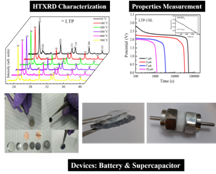 Indian researchers have developed a thermally stable solid electrolyte for lithium-ion batteries for energy storage that promise application for a wide range of temperatures from 30-500 degrees Celsius. Energy generation and storage is the need of the hour, and worldwide efforts are being invested for developing cost-effective, efficient options. The current state of art indicates a possible replacement of conventional low energy density, low shelf life batteries with Lithium-ion and Sodium-ion batteries. However, there are several scientific and technical limitations in the present technology, for example, dependence of liquid electrolytes and narrow range of operating temperatures. Therefore, efforts are required to develop solid-state energy storage devices. In this direction, a group of researchers led by Dr. Anshuman Dalvi of Department of Physics, BITS Pilani, Pilani Campus has developed solid-state energy storage devices in the form of thermally stable solid electrolytes for Li+ ion batteries and supercapacitors and tested their stability and efficiency using state of the art facilities.
Indian researchers have developed a thermally stable solid electrolyte for lithium-ion batteries for energy storage that promise application for a wide range of temperatures from 30-500 degrees Celsius. Energy generation and storage is the need of the hour, and worldwide efforts are being invested for developing cost-effective, efficient options. The current state of art indicates a possible replacement of conventional low energy density, low shelf life batteries with Lithium-ion and Sodium-ion batteries. However, there are several scientific and technical limitations in the present technology, for example, dependence of liquid electrolytes and narrow range of operating temperatures. Therefore, efforts are required to develop solid-state energy storage devices. In this direction, a group of researchers led by Dr. Anshuman Dalvi of Department of Physics, BITS Pilani, Pilani Campus has developed solid-state energy storage devices in the form of thermally stable solid electrolytes for Li+ ion batteries and supercapacitors and tested their stability and efficiency using state of the art facilities.
 The establishment of the FIST program of the Department of Science & Technology (DST), Govt. of India supported XRD facility has given a new dimension to the ongoing research by providing them infrastructural support to investigate composite materials at high temperature with great resolution. This work has been published in the journal ‘Materials Research Bulletin in 2021’. The team has used DST FIST-supported High-temperature X-ray diffraction (HTXRD) facility Rigaku SmartLab, particularly useful for the thermal stability assessment of novel solid electrolytes. The XRD patterns were obtained in situ up to 500 oC. Now, the batteries and supercapacitors to operate at high temperatures are being developed. The results from HTXRD patterns (technique used to study the structural changes in the material as a function of temperature) for the range 30-500 oC for the ionic liquid (IL) dispersed sol-gel derived NASICON( superionic sodium conductors) structured LiTi2(PO4)3 (LTP) composites indicated that IL does not react with LTP at higher temperatures to form unwanted compound.
The establishment of the FIST program of the Department of Science & Technology (DST), Govt. of India supported XRD facility has given a new dimension to the ongoing research by providing them infrastructural support to investigate composite materials at high temperature with great resolution. This work has been published in the journal ‘Materials Research Bulletin in 2021’. The team has used DST FIST-supported High-temperature X-ray diffraction (HTXRD) facility Rigaku SmartLab, particularly useful for the thermal stability assessment of novel solid electrolytes. The XRD patterns were obtained in situ up to 500 oC. Now, the batteries and supercapacitors to operate at high temperatures are being developed. The results from HTXRD patterns (technique used to study the structural changes in the material as a function of temperature) for the range 30-500 oC for the ionic liquid (IL) dispersed sol-gel derived NASICON( superionic sodium conductors) structured LiTi2(PO4)3 (LTP) composites indicated that IL does not react with LTP at higher temperatures to form unwanted compound.
The composite was used in Lithium button cells. Excellent stability has been achieved under battery conditions. The composite promises battery application for a wide range of temperature. Further, the samples are being used as electrolytes for electric double-layer (EDLC) supercapacitors. A high capacity of around 200 F/g and thermal stability at least up to 100 oC has been achieved for 10000 cycles. The EDLCs was used to power LEDs successfully. Efforts are on to fabricate EDLCs operating at 200 oC. Dr Dalvi further elaborated, “Ionic liquid composites with NASICONs, Garnets, and some other fast ionic solids have been found to be promising for high-temperature energy storage devices. These devices are strategically important for military and space applications.”

